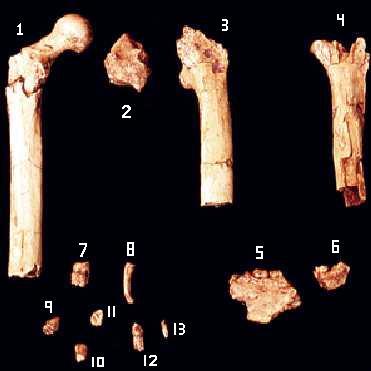
Hominid Species Time Line
Page 5
Orrorin tugenensis
Dated to around 6 million years ago; the name means “original man” in Tugen, the African language spoken in the region, and tugenensis refers to the discovery site, the Tugen Hills of western Kenya. This site is within the region affected by frequent volcanism in the Miocene and Pliocene eras, so the bones can be dated with some precision to between 6.1 and 5.8 million years ago. At the time of their discovery, this was by far the oldest remains of any hominid species.
Discovered in 2000 by a French expedition led by Brigitte Senut and Martin Pickford from the Muséum national d'histoire naturelle of Paris, this species — the sole representative of its genus thus far — has surprisingly “modern” characteristics.
Bones of Orrorin tugenensis
Orrorin tugenensis is thus far represented by only a few fragments of bone — some isolated teeth, parts of two lower jaws, and fragments of arm and leg bones, representing in all perhaps five individuals (see above). The significance of the discovery, however, far exceeds the apparent paucity of remains. The teeth are small and remarkably human-like. The attachment of the femur to the hip (the ball joint) is, according to anatomical experts, direct evidence of bipedalism. Although this species, like all the earliest hominids discovered so far, was about the size of a chimpanzee — in this case, a female chimpanzee — its leg bones are 1.5 times the length of “Lucy’s” species, A. afarensis.
The discoverers claim on the basis dental anatomy and advanced bipedal locomotion that this creature was in the direct line of descent to modern humans. If this view is correct, then all of the australopithecine species would represent a collateral line or lines, rather than human ancestors. The human line would presumably stretch from an as yet undiscovered species at the point of divergence through Orrorin tugenensis, and from thence through Kenyanthropus platyops (?) and several as yet undiscovered species to the earliest Homo species who lived three million years ago or shortly thereafter. This line of descent would be a huge revision of recent thinking about human development.
At the very least, this discovery of a six-million year old hominid has invalidated the lower end of the estimated time of the chimp-hominid split based on the “molecular clock” theory. We now know the divergence took place considerably earlier than five million years ago. This species and S. Tchadensis provide the clinching evidence.
On the basis of these considerations, the discoverers of Orrorin tugenensis placed these specimens in a new genus as well as a new species. [Senut, B. et al. "First hominid from the Miocene (Lukeino Formation, Kenya)", Comptes Rendus de l’Académie des Sciences - Series IIA - Earth and Planetary Science Volume 332, Issue 2, 30 January 2001, Pages 137-144]. An interesting side issue is that this species lived in a dry conifer forest environment, and their arms appear adapted to tree climbing though not to brachiating.
For a skeptical view of these claims see Aiello, Leslie C. and Collard, Mark (Paleoanthropology our newest oldest ancestor", Nature (29-Mar-2001), 526-527). A later paper (Galik, K. and Senut, B, et al. ("External and Internal Morphology of the BAR 1002'00 Orrorin tugenensis Femur", Science (3-Sep-2004), 1450-1453) has found further evidence of bipedalism in the fossil femur.
References:
Aiello, Leslie C. and Collard, Mark "Paleoanthropology - Our Newest Oldest Ancestor" Nature 410, 29 March 2001, 526-527
Galik, K., Senut, B., et al. "External and Internal Morphology of the BAR 1002'00 Orrorin tugenensis Femur", Science v.305 n.5689, 3-Sep-2004, pp. 1450-1453
Senut, B. et al. "First hominid from the Miocene (Lukeino Formation, Kenya)", Comptes Rendus de l’Académie des Sciences - Series IIA - Earth and Planetary Science Volume 332, Issue 2, 30 January 2001, Pages 137-144
Orrorin tugenensis on TalkOrigins.org